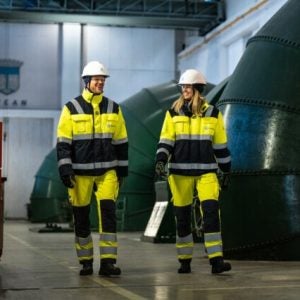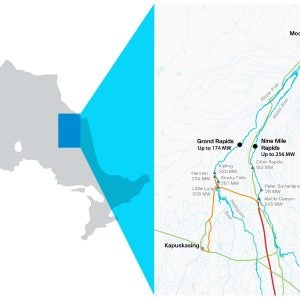The 30MW power plant is the latest in a series of major fish-enhancement initiatives undertaken by PSE as part of its 50-year federal operating license for the Baker River Hydroelectric Project. Among other things, the 2008 license requires a minimum downstream flow from PSE’s Lower Baker Dam of at least 1000ft3/sec. The project’s previous license, issued in 1956, required flows of approximately 80ft3/sec to support upstream fish-passage facilities.
“With this new power plant, we’re not only improving river flows for Puget Sound salmon, but we’re increasing our capacity to generate renewable hydropower for the region and providing an economic boost to the local economy,” said PSE government and community relations manager Ray Trzynka. “It’s a win for the environment, for our local communities and for our customers.”
Besides increasing the minimum downstream flows passing through Lower Baker Dam, the new powerhouse’s 30MW turbine will reduce the ramping rate at which PSE is able to take its power-generating operation offline. A slower ramping rate lessens the chances of juvenile salmon becoming stranded in side channels along the river as downstream water levels rise or fall. Resource agencies say the increase in downstream flows and a slower ramping rate will help salmon migration and spawning.
The larger 79MW turbine in PSE’s existing Lower Baker Dam powerhouse cannot operate efficiently under the new license’s required flow regimes. Instead of spilling water to meet the new requirements, Trzynka noted, PSE opted to build a second Lower Baker powerhouse immediately downriver that can take advantage of the flow directives in the new license.
The new powerhouse, scheduled for completion in late 2013, will raise the power capacity of PSE’s two Baker River dams from 170MW to 200MW. PCL Construction Services, of Seattle, is the project’s general contractor.
PSE has been collaborating with federal and state resource agencies and local Native American tribes for more than 20 years on a salmon-recovery plan for salmon in the Baker and Skagit river basins. The effort has accelerated dramatically under PSE’s new Baker River Hydroelectric Project license.
In 2008, PSE completed construction of an internationally lauded “floating surface collector” on Baker Lake for moving juvenile salmon downstream around PSE’s two Baker River dams. Then earlier this year, the utility finished building an advanced fish trap for moving adult Baker River salmon upstream, and a new, large fish hatchery along Baker Lake. Three years from now, PSE will complete a second surface collector for juvenile salmon, this time on Lake Shannon.
The investments and collaborative work already are starting to show impressive results. In 2009, the Baker Lake surface collector set a new record for downstream migration of young Baker River sockeye, and this past spring, it broke the record again, with more than 520,000 juvenile salmon collected and transported by truck around PSE’s dams. Also this past summer, the highest run of adult sockeye on record – more than 22,500 – migrated up the Baker River.
Fisheries agencies say PSE’s investments and collaborative efforts could produce annual sockeye runs on the Baker River of 50,000 to 75,000 fish. The sockeye run’s historical average is about 3,000 fish.
Lower Baker Dam, completed in 1925, is a 285ft high concrete structure with 79MW of power generating capacity. The 312ft high Upper Baker Dam, completed in 1959, has a generating capacity of 91MW.






